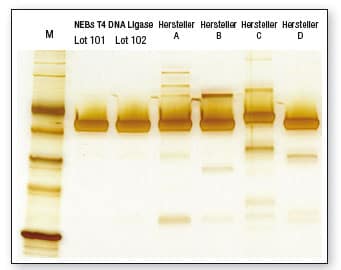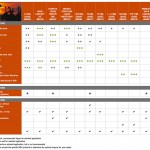Ligation of DNA is a critical step in many modern molecular biology workflows. The sealing of nicks between adjacent residues of a single-strand break on a double-strand substrate and the joining of double-strand breaks are enzymatically catalyzed by DNA ligases.
Advantages
- Fast ligations
- Robust ligation efficiency
- Industry standard for purity
- Most extensive selection commercially available
- New formulations optimized for your substrates
- Convenient master mix formats

Extreme purity with NEB’s T4 DNA Ligase
Equivalent amounts of protein were loaded and silver stained using SilverXpress™. Marker M is NEB’s Broad Range Protein Marker (NEB #P7702).
| T4 DNA Ligase Quality Control | ||
| Physical Purity | Determined by SDS-PAGE analysis (silver stained gel) (Figure 1). | |
| Exonuclease Activity | Contaminating exonucleases are assayed by monitoring release of radioactively labeled DNA substrate. Very low levels of specific types of exonuclease contamination are also assayed for using capillary electrophoresis with dye labeled substrate (Figure 2). | |
| Nuclease Activity | Contaminating nucleases are assayed by incubation with HindIII fragments of lambda DNA. | |
| Endonuclease Activity | Incubation with supercoiled plasmid DNA for 4 hours is used to detect any nicking or nonspecific nuclease degradation. | |
| Functional Assay | Room temperature ligation is performed. | |
Further information can be found in our Technical Resources section or at neb.com. Information on trademarks can be found here.


